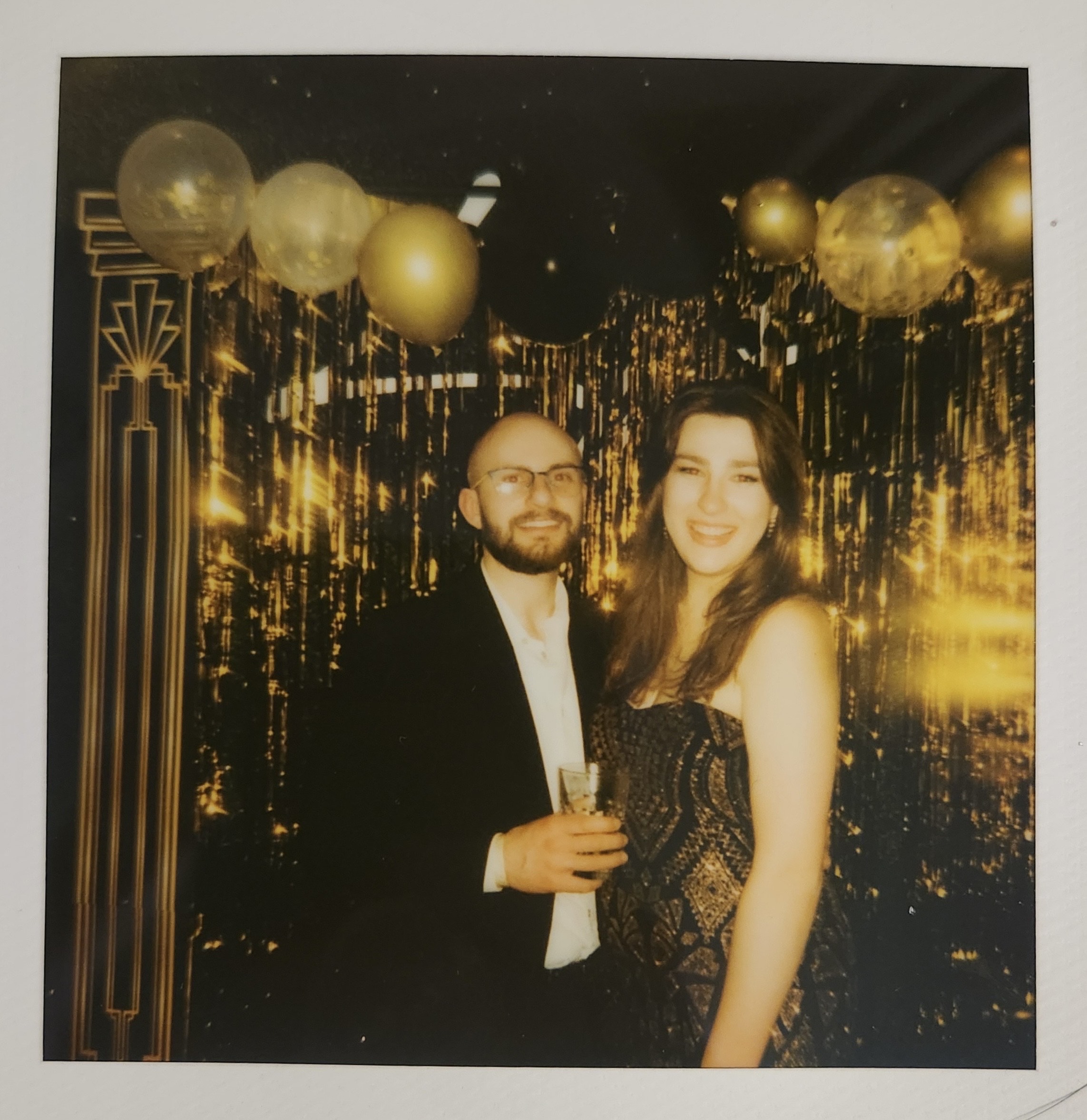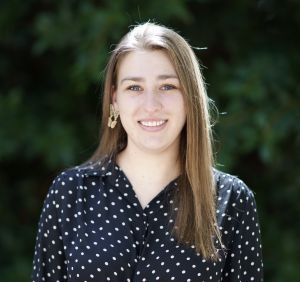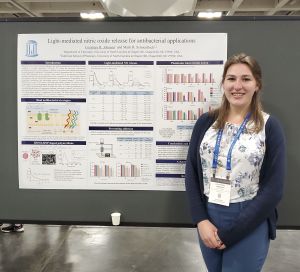From Lab Bench to Dance Floor, Courtney Johnson Leads with Creativity and Empathy

Fifth-year Ph.D. student Courtney Johnson with her husband at UNC-Chapel Hill’s first “Chemistry Prom,” which she organized as president of the Association for Chemistry Graduate Students.

May 22, 2025 I By Dave DeFusco
In the glow of a crowded rooftop lounge at UNC-Chapel Hill’s first “Chemistry Prom,” fifth-year Ph.D. student Courtney Johnson watched as her peers danced, laughed and snapped Polaroids—each photo a tiny, tactile moment of joy. Months earlier, the event was only an idea—a dream Johnson fought to realize as president of the Association for Chemistry Graduate Students. That night, it became something more: a celebration of unity in a world often divided by stress, isolation and uncertainty.
Johnson, who specializes in analytical chemistry in the Schoenfisch Lab, is no stranger to balancing complexity. Her daily life is a blend of cutting-edge chemical research and tireless leadership in service to her department and peers. Whether she’s optimizing nitric oxide delivery systems for next-generation wound care or negotiating dress code compromises for graduate student socials, Johnson approaches every problem the same way: listen deeply, think creatively and lead with empathy.
At the heart of Johnson’s doctoral research is a deceptively simple molecule: nitric oxide (NO). Though fleeting and invisible, this gas plays a powerful role in human biology. “Nitric oxide is one of the body’s natural signaling molecules,” said Johnson. “At low concentrations, it promotes healing by encouraging blood flow and tissue regeneration. But at higher concentrations, it can actually kill harmful bacteria.”
Her challenge was to design materials that can deliver the right dose of NO at the right time and place to treat chronic wounds, dental infections and skin conditions without harming healthy cells. To do this, Johnson works with a special class of light-activated compounds called S-nitrosothiols (RSNOs). These molecules store nitric oxide like a battery and release it when exposed to light. By modifying RSNOs onto silica nanoparticles and incorporating them into materials like polyurethane—substances that mimic real wound dressings—Johnson creates tiny delivery systems that release NO in response to light from LEDs.

This technique, called photo-labile nitric oxide delivery, allows researchers to “turn on” NO release when and where it’s needed. By adjusting the light’s wavelength and intensity, Johnson can control how fast and how much nitric oxide is released. Shorter wavelengths like blue light release larger bursts for immediate antibacterial action. Longer, lower-energy wavelengths create a slow trickle of NO—ideal for encouraging tissue repair over time.
In a recent publication in ACS Biomaterials Science & Engineering, Johnson demonstrated how these tunable systems effectively kill harmful bacteria while remaining safe for human skin cells. Her research has implications for treating infected wounds—especially those involving antibiotic-resistant pathogens—by delivering a powerful one-two punch: the antibacterial properties of blue light combined with the microbe-killing capabilities of nitric oxide.
“Because NO kills bacteria in several different ways—damaging their DNA, cell membranes and proteins—it’s much harder for bacteria to develop resistance,” she said. “That makes it a very promising alternative or complement to antibiotics.”
While Johnson’s research pushes scientific boundaries, her leadership has transformed the graduate student experience in the UNC Chemistry Department. In addition to her role as ACGS president, she has served on the Graduate Studies Committee, the Graduate Committee for Professional Development, the Scientific Outreach Committee and even helped coordinate two visits from a Procter & Gamble vice president.
Through it all, she has stayed grounded in collaboration and communication. One example she reflects on often is the Chemistry Prom dress code debate. “I wanted it to be a formal event similar to the medical school prom—formal gowns, suits, the whole thing,” she said. “But there was concern that not everyone would be able to afford a new prom dress or still fit into their high school suit.”
The solution was pure Courtney: listen to every concern, validate different experiences and find a middle path. “We ended up encouraging people to wear what made them feel good, whether that was a formal gown or jeans and a button-down,” she said. “It wasn’t about the clothes; it was about giving people a chance to relax and celebrate.”
She even contributed a personal touch: “I’m obsessed with Polaroid cameras, so we used my cameras and bought a bunch of film,” she said. “Now when I walk through the building, I still see those photos on people’s desks.”
Johnson’s leadership also extends into the lab, where she mentors undergraduate researchers and fosters an environment of respect and confidence. “You can’t just assume that people know what to do,” she said. “You have to meet people where they are—just like you do in a committee or a classroom.”
That same perspective shapes her scientific problem-solving. “If you want to treat a wound or a dental infection, you have to think not just about killing bacteria but about how human tissue responds to treatment. It’s always a balancing act.”
Currently, she’s expanding her research to explore NO delivery for anaerobic pathogens—the types of bacteria that thrive in oxygen-free environments like the mouth and deep skin tissues. By matching light parameters to both bacterial vulnerabilities and human tissue safety, Johnson is working toward dual-action therapies that are as smart as they are effective.
As Johnson nears the end of her Ph.D., her contributions have left a lasting imprint—not only in her field, but in the faces and memories of the community she helped build. Her work reminds us that the brightest science often emerges at the intersection of compassion, creativity and collaboration.
“We talk a lot about innovation in science,” she said, “but innovation doesn’t happen in a vacuum. It happens when people feel supported, when their ideas are heard and when they feel like they belong. That’s what I’ve tried to help build here, whether through a research breakthrough or a prom night.”

